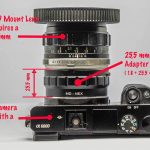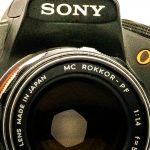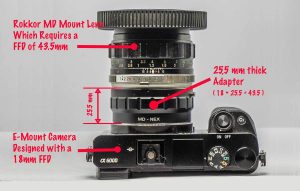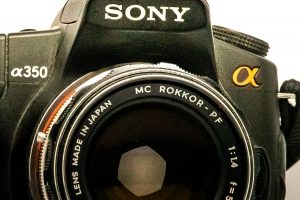There is intense interest in the yet unnamed and unannounced full frame Sony Alpha (possibly to be called the A900?) among Alphatracks readers. I recently received another e-mail suggesting further ideas regarding the full frame sensor with in-camera image stabilization problem. Or non-problem, depending on which theory you wish to follow.
This time around, Marek Kaszycki weighs in with his analysis of the situation.
I’m not an engineer, yet I’d like to provide another perspective on the possibilities of SSS working with a full frame sensor.
Looking at tests of stabilization systems, I can’t help but wonder about two things:
1. Effectiveness of stabilization overall.
2. Effect of lack of stabilization.
Starting with the latter, it’s fairly obvious that if you take a 3600×2400 image (ca 8.6 megapixels) and have a shake that causes smearing of fine detail across two pixels, you’re losing 50% of the linear resolution in that direction. Since losing 50% of resolution in one direction leads to the perception of losing half of the resolution overall (extra resolution in the other direction is redundant), this means losing 75% of the pixel count, reducing the perceived resolution down to 1800×1200, ie. ca. 2 megapixels. Worse shake leads to further image degradation with even further loss of resolution, down to unacceptable levels.
I used the images from some dpreview reviews for Minolta cameras:
http://www.dpreview.com/reviews/KonicaMinoltaA200/page7.asp
http://www.dpreview.com/reviews/KonicaMinolta7D/page19.asp
http://www.dpreview.com/reviews/KonicaMinoltaZ5/page6.asp
They have different sensor sizes and pixel counts, so I will use relative numbers.
The Z5 is 5 megapixels, 2560×1920, Dynax 7D is 6 megapixels, 3008×2000, and Dimage A200 is 8 megapixels, 3264×2448.
The Z5, at 420 mm equivalent focal length, produces a blur about 30 pixels long, the D7D, at 75 mm equivalent, about 15 pixels (at 1/4th, with AS on, curiously), and the A200 about 35 pixels. Relative number of pixels per frame height is: 1.5%, 0.75% and 1.4%.
Since D7D handily corrected blur at 1/8th of a second, which is almost ten times longer than ‘handholdable without stabilization’ 1/focal length rule, with about 0.5 pixel shift, it’s perfectly reasonable that the system has a three stop effectiveness with 0.75% frame height shift (0.12 mm movement of a 16 mm high sensor!).
Let’s say the system would correct for even more, and would move the frame within 4% around the sensor boundaries. This would correct about 5.5 stops slower than at the reciprocal of the focal length rule, while moving the sensor only about 0.96 mm up and down, and 1.44 mm left and right. Amazingly simple, let’s simplify that further and allow for 1.5 mm movement in both axes in both directions, which is a bit extreme.
Taking a full frame film gate, and a full frame shutter (both of which have sligthly larger clearance than 36×24 mm), as well as a full frame sensor, we lose 3 mm of the sensor to allow SSS to work. It boils down to 33×21 mm available area, or 31.5×21 mm to allow 3:2 aspect ratio. This means a “crop factor” of only 1.14x, making a 24 mm lens into a 27 mm one. Still a loss, but I think it’s an acceptable one.
What could Sony do to make us happy? In this rather extreme example (3 mm movement), three things:
1. Setting SSS effectiveness in the menu. Restrict movement to 0.25 0.5, 0.75, 1, 1.5, 2, 2.5 and 3 mm, independently for horizontal and vertical axes (e.g. 2 mm for vertical axis and 3 mm for horizontal, making image area equal to 33×22 mm, or less than 1.1x crop).
2. Letting users choose whether to always crop the image to preset restricted movement, leave it as it is, to crop it in software, or crop it automagically (the camera would crop based on restricted movement and detected underexposure).
3. When SSS is off, no crop occurs, unless preset in the menu (automatic mask in the viewfinder).
Back to the 3600×2400 sensor (8.64 megapixels), a 31.5×21 mm available area is 3150×2100 pixels, 6.61 megapixels. Not a huge loss in resolution, either (linear: 14%, planar: 23%).
All of these options are possible, no extra gain, or exposure increase is necessary, the sensor is full frame when doing critical work, and slightly smaller when not.
Regards, Marek Kaszycki
Past posts in this series:
- https://alphatracks.com/archives/81
- https://alphatracks.com/archives/82
- https://alphatracks.com/archives/83
Technorati tags









More Stories
No longer an Underdog, Sony cameras and lenses win multiple categories at TIPA 2022 World Awards
Mirrorless vs dSLR Cameras in poor Light: the EVIL avantage
Shooting after Dark at Bit of Hope Ranch’s “Hooftober”